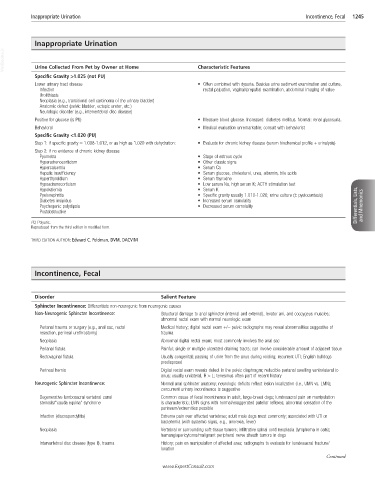Page 2496 - Cote clinical veterinary advisor dogs and cats 4th
P. 2496
Inappropriate Urination Incontinence, Fecal 1245
Inappropriate Urination
VetBooks.ir Urine Collected From Pet by Owner at Home Characteristic Features
Specific Gravity >1.025 (not PU)
Lower urinary tract disease • Often combined with dysuria. Besides urine sediment examination and culture,
Infection rectal palpation, vaginal/preputial examination, abdominal imaging of value
Urolithiasis
Neoplasia (e.g., transitional cell carcinoma of the urinary bladder)
Anatomic defect (pelvic bladder, ectopic ureter, etc.)
Neurologic disorder (e.g., intervertebral disc disease)
Positive for glucose (is PU) • Measure blood glucose. Increased: diabetes mellitus. Normal: renal glycosuria.
Behavioral • Medical evaluation unremarkable; consult with behaviorist
Specific Gravity <1.020 (PU)
Step 1: if specific gravity = 1.008-1.012, or as high as 1.020 with dehydration: • Evaluate for chronic kidney disease (serum biochemical profile + urinalysis)
Step 2: if no evidence of chronic kidney disease:
Pyometra • Stage of estrous cycle
Hyperadrenocorticism • Other classic signs
Hypercalcemia • Serum Ca
Hepatic insufficiency • Serum glucose, cholesterol, urea, albumin, bile acids
Hyperthyroidism • Serum thyroxine
Hypoadrenocorticism • Low serum Na, high serum K; ACTH stimulation test
Hypokalemia • Serum K
Pyelonephritis • Specific gravity usually 1.010-1.020; urine culture (± pyelocentesis)
Diabetes insipidus • Increased serum osmolality
Psychogenic polydipsia • Decreased serum osmolality Differentials, Lists, and Mnemonics
Postobstructive
PU, Polyuric.
Reproduced from the third edition in modified form.
THIRD EDITION AUTHOR: Edward C. Feldman, DVM, DACVIM
Incontinence, Fecal
Disorder Salient Feature
Sphincter Incontinence: Differentiate non-neurogenic from neurogenic causes
Non-Neurogenic Sphincter Incontinence: Structural damage to anal sphincter (internal and external), levator ani, and coccygeus muscles;
abnormal rectal exam with normal neurologic exam
Perianal trauma or surgery (e.g., anal sac, rectal Medical history; digital rectal exam +/− pelvic radiographs may reveal abnormalities suggestive of
resection, perineal urethrostomy) trauma
Neoplasia Abnormal digital rectal exam; most commonly involves the anal sac
Perianal fistula Painful; single or multiple ulcerated draining tracts; can involve considerable amount of adjacent tissue
Rectovaginal fistula Usually congenital; passing of urine from the anus during voiding; recurrent UTI; English bulldogs
predisposed
Perineal hernia Digital rectal exam reveals defect in the pelvic diaphragm; reducible perianal swelling ventrolateral to
anus; usually unilateral, R > L; tenesmus often part of recent history
Neurogenic Sphincter Incontinence: Normal anal sphincter anatomy; neurologic deficits reflect lesion localization (i.e., UMN vs. LMN);
concurrent urinary incontinence is suggestive
Degenerative lumbosacral vertebral canal Common cause of fecal incontinence in adult, large-breed dogs; lumbosacral pain on manipulation
stenosis/“cauda equina” syndrome is characteristic; LMN signs with normal/exaggerated patellar reflexes; abnormal sensation of the
perineum/extremities possible
Infection (discospondylitis) Extreme pain over affected vertebrae; adult male dogs most commonly; associated with UTI or
bacteremia (with systemic signs, e.g., anorexia, fever)
Neoplasia Vertebral or surrounding soft-tissue tumors; infiltrative spinal cord neoplasia (lymphoma in cats);
hemangiopericytoma/malignant peripheral nerve sheath tumors in dogs
Intervertebral disc disease (type II), trauma History; pain on manipulation of affected area; radiographs to evaluate for lumbosacral fracture/
luxation
Continued
www.ExpertConsult.com

